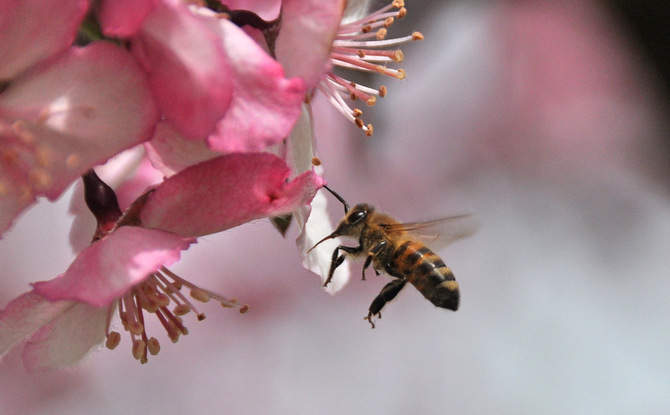
Past
Colony Collapse Disorder (CCD) started popping up in the news around 2006. Not many people knew what the problem was attributed to back then, but a lot of people had sneaking suspicions. Even back then, man-made influences were the first suspects, for example pollution or pesticides.
Then articles starting coming out of small studies that suggested that bees couldn’t find flowers anymore because flowers were losing their scent. It clearly concluded that due to pollution, flowers scent molecules no longer travel as far as they use to. Air pollution was then identified as a potential link to literally killing the scent trail that pollinators like honeybees use to track down flowers. While it was too difficult to say whether this was the sole cause of colony collapse disorder back then, it was certainly recognized as a contributing factor because researchers at the University of Virginia were confident they proved pollutants were killing scent trails.
Eco Fact:
1/3 of the nations food supply depends on honeybee pollination including apples, almonds, blueberries, melons, and citrus fruits.
The “prime suspect” for the collapse even in 2006-2007, was an increasingly popular class of pesticides called neonicotinoids that the U.S. Environmental Protection Agency determined as highly toxic to honeybees.
Several veteran honeybee keepers around the country were speaking out, sounding the alarms, and proclaiming that the industry was on the verge of collapse.
Reports from more than 22 states were claiming that they were seeing honeybee deaths, some reporting over 50% of their colonies dying off. Upon dissection of the dead honeybees, abnormally high number of foreign fungi, bacteria and other organisms were found to have left there immune systems weakened. Other researchers suspected that pesticides might had something to do with it.
At the time, my opinion on the matter was that it was a combination of pesticides, greenhouse gas emissions, pollution, and general human negligence.
Present
50,000 BumbleBee deaths were attributed to pesticide use in Oregon … specifically the pesticide Safari. The Oregon Department of Agriculture confirmed the mis-use of the pesticide was the cause of the mass bee deaths in Wilsonville, Oregon.
The main ingredient is Safari is dinotefuran, a neonicotinoid. Neonicotinoids are known to be toxic to bees and has been a suspect cause for ‘colony collapse disorder’. The European Union has even gone as far as issuing a ban this year on 3 types of neonicotinoids (clothianidin, imidacloprid, and thiametoxam) that will go into effect this December.
According to the EPA:
Neonicotinoids:
“are a class of insecticides with a common mode of action that affects the central nervous system of insects, causing paralysis and death..Some uncertainties have been identified since their initial registration regarding the potential environmental fate and effects of neonicotinoid pesticides, particularly as they relate to pollinators.”
“Data suggest that neonicotinic residues can accumulate in pollen and nectar of treated plants and may represent a potential exposure to pollinators. Adverse effects data as well as beekill incidents have also been reported, highlighting the potential direct and/or indirect effects of neonicotinic pesticides. Therefore, among other refinements to ecological risk assessment during registration review, the Agency will consider potential effects of the neonicotinoids to honeybees and other pollinating insects.”
As a result of the 50,000 bumblebee deaths in Oregon, the Department of Agriculture issued a temporary ban itself on 18 insecticides with the active ingredient dinotefuran. While the 6 month moratorium has started in Oregon on the ban of neonics, local non-profits like Beyond Toxics are calling for an outright ban.
What we know now is that scientists from all over the world are looking very closely at this issue. From what it looks like, multiple issues seem to be at play ranging from parasitic mite, multiple viruses, bacteria, poor nutrition, genetics, habitat loss and pesticides.
Many environmentalists have taken the plight of the honeybee to heart by calling on bans of neonicotinoids (neonics) which are a sort of new class of systemic pesticides. This makes the pesticides accumulate in the plant matter and subsequently the pollen which makes it toxic for honeybees and other insects (even the good ones).
Beekeepers in the United States are teaming up with non-profits like the Pesticides Action Network to help get neonics banned through the EPA. Some beekeepers are going as far as suing the EPA to help protect honeybees and the honey/pollinating industry.
It’s no wonder why so many people are pointing the finger at neonics, when farmers like Dave Schuit from Elmwood, Canada lost at least 600 hives representing over 37 million honeybees! Farmer Dave says Bayer CropScience is to blame because they are the manufacturers of these pesticides.
Future
When the European Food And Safety Authority has its own scientists identify potential risks to honeybees from Neonicotinoids then we could all take a step back and remember something called the Precautionary Principle.
If researchers and scientists can come together and at least agree that pesticides are a part of the problem to mass honeybee deaths, then as a society, we should do what we can to protect these important pollinators and our overall general health. We must remind ourselves that pesticides are poisons that we willingly spray on our food supply which we would all rather do without.
The temporary bans on neonics going into effect around the world are an encouraging sign that more precautions need to be taken before allowing poison companies to release their products into the environment without fully testing their products.





Leave a Comment